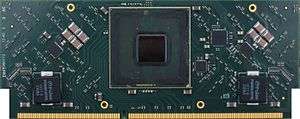Microserver
| DOME P5020 Microserver | |
|---|---|
 | |
| 139mm x 55mm compute node |
| DOME T4240 Microserver prototype | |
|---|---|
| | |
| T4240 revision 1 prototype board, running Fedora 20, 21 Jan 2015 |
A microserver is a server class computer which is based on a system on a chip (SoC). The goal is to integrate most of the server motherboard functions onto a single microchip, except DRAM, boot FLASH and power circuits.[1] Thus, the main chip contains more than only compute cores, caches, memory interfaces and PCI controllers. It typically also contains SATA, networking, serial port and boot FLASH interfaces on the same chip. This eliminates support chips (and therefore area, power and cost) at the board level. Multiple microservers can be put together in a small package to construct a microdatacenter.
History
The term microserver first appeared in the late 90's and was popularized by a Palo Alto incubator; PicoStar [2] when incubating Cobalt Microservers. Microserver again appeared around 2010 and is commonly misunderstood to imply low performance.[3] Microservers originate from the embedded market, where due to cost and space these types of SoCs appeared before they did in general purpose computing. Indeed, recent research indicates that emerging scale-out services and popular datacenter workloads (e.g., as in CloudSuite[4]) require a certain degree of single-thread performance (with out-of-order execution cores) which may be lower than those in conventional desktop processors but much higher than those in the embedded systems.[5]
A modern microserver typically features medium-high performance at high packaging densities, allowing very small compute node form factors. This can result in high energy efficiency (operations per Watt), typically better than that of highest performance processors.[6]
One of the early microservers is the 32-bit SheevaPlug. There are plenty of Consumer-Grade 32-bit microservers available, for instance the Banana Pi as seen on Comparison of single-board computers. Early 2015, even a 64-bit Consumer-Grade microserver is announced.[7] Data-Center-grade microservers need to be 64-bit and run server class operating systems such as RHEL or SUSE.
Commercialization
- Dell was among the first to build a commercially available microserver. In May 2009 Dell launched the Fortuna platform based on VIA's Nano processor. The system was designed for a specific European customer.[8]
- SeaMicro followed shortly after Dell with one of the first generally available microservers. SeaMicro launched the SM10000 in June 2010. The SM1000 was based on Intel's Atom processor.[9] SeaMicro followed the SM1000 with the SM1000-64 using a 64 bit Atom processor,[10] and then switched to Intels Sandy Bridge processor for the SM1000-XE [11] in 2011. They were acquired by AMD in 2012.
- Calxeda, now out of business,[12] was one of the first companies to start building ARM based microservers, using 32-bit ARM cores. They went out of business before they could make the transition to 64-bit.
- Hewlett-Packard has the commercial Moonshot [13] product line with 64bit capability.
In 2015 microservers, sometimes also (confusingly) called 'scale-out servers' or even 'scale-in servers' are getting plenty of attention in the press.[14]
See also
References
- ↑ "Dual function heat-spreading and performance of the IBM / Astron DOME 64-bit μServer demonstrator", R. Luijten, A. Doering and S. Paredes, ICICDT, May 2014, Austin, TX
- ↑ "Trademark search 'microserver' here;" http://tmsearch.uspto.gov/
- ↑ "FAWN: A Fast Array of Wimpy Nodes". D. Andersen et. al. Proc. 22nd ACM Symposium on Operating Systems Principles (SOSP 2009), Big Sky, MT. October 2009.
- ↑ "The CloudSuite". http://parsa.epfl.ch/cloudsuite.
- ↑ "Clearing the Clouds". M. Ferdman et. al. Proc. 17th ACM International Conference on Architectural Support for Programming Languages and Operating Systems (ASPLOS), 2012.
- ↑ "Energy Efficient MicroServer based on a 12-core 1.8GHz 188K Coremark 28nm Bulk CMOS 64-bit SoC for Big-Data Applications with 159GB/s/liter Memory Bandwidth System Density.", R. Luijten, D. Pham, R. Clauberg, H. Nguyen, M. Cossale, M. Pandya, ISSCC 2015, Feb 2015, San Francisco
- ↑ Allwinner Nobel64 is a 64-bit dev board
- ↑ http://www.pcper.com/news/Processors/Nano-finds-itself-curious-place-Dell-Fortuna-servers
- ↑ http://www.anandtech.com/show/3768/seamicro-announces-sm10000-server-with-512-atom-cpus-and-low-power-consumption/3
- ↑ http://www.theregister.co.uk/2011/07/18/seamicro_sm10000_64hd_upgrade/
- ↑ SeaMicro SM10000-XE homepage
- ↑ ARM server developer Calxeda shuts down
- ↑ HP Moonshot System homepage
- ↑ ARM Challenging Intel in the Server Market: An Overview